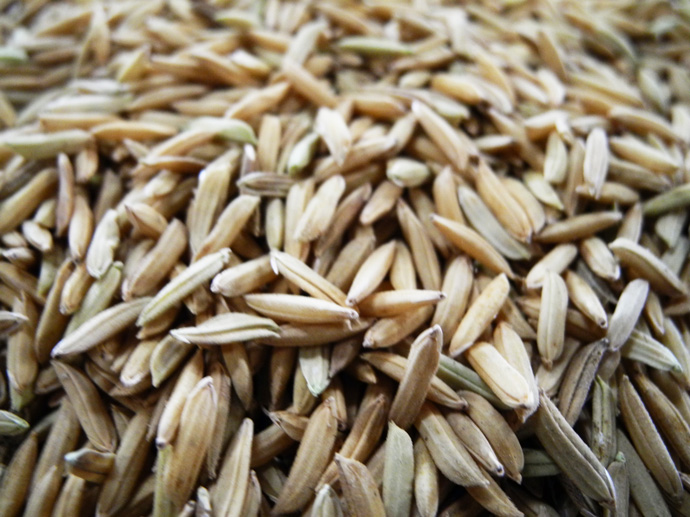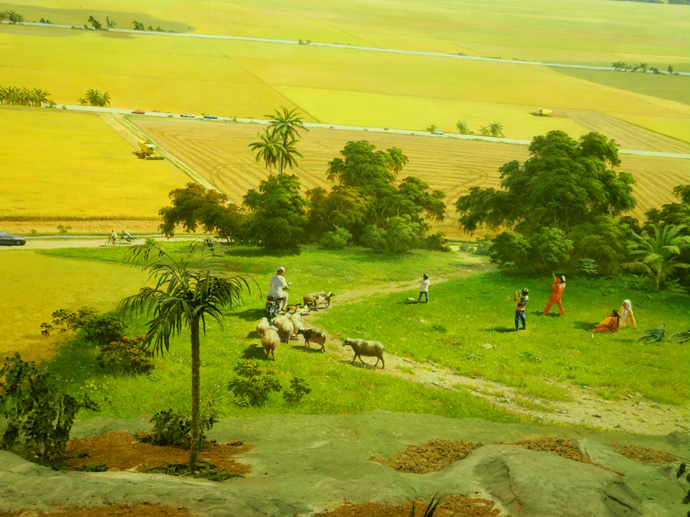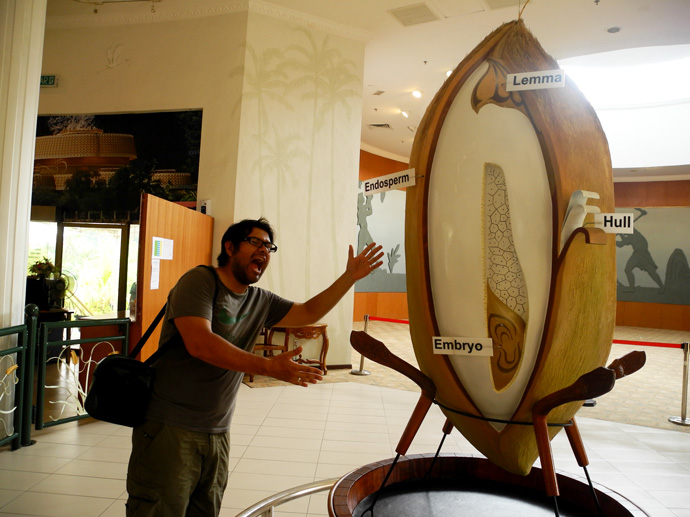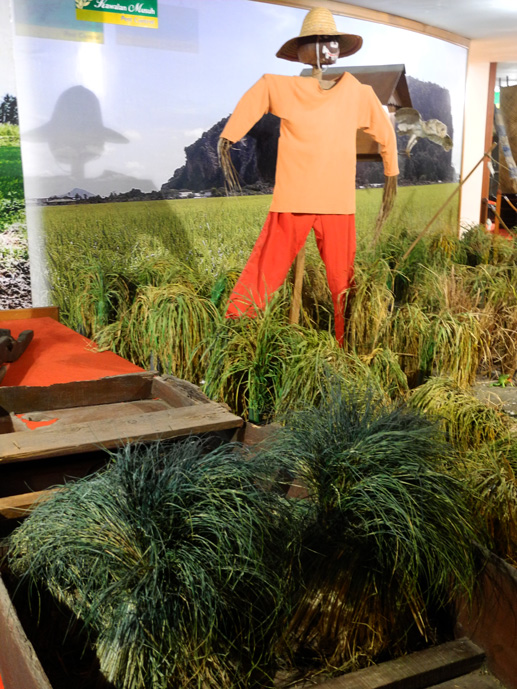Kuala Lumpur, December, 2013
The History of Rice
“One Beef Redang please”, I ordered my favorite Malaysian dish on a small restaurant along the road with no sign or name in it’s walls. We basically stumbled upon it while cycling somewhere in the middle of Melacca and Johor provinces. Although the place looked a bit shabby we had already learned a long time ago that this factor is absolutely no reason to underestimate it’s quality.
After about 10 minutes my Beef Redang came in the hands of our friendly waiter, a young girl with thin complexion and light white skin who was also the cook. Along with my order came a big plate of hot, chunky, white rice served as if it was a small mountain of edible glory.
It has been almost two years since we first entered Asia and in most of it’s countries, if not all, there is one particular thing that unites them all as one big Asian culture: Rice.
Food is an excellent way to literary “taste the culture of a country” or in this case a continent. Rice has been a delicious discovery that has given us many leads in understanding the ways and the costumes of our fellow humans living on this part of the earth. Take Plov for example, or as I like to call it The Food that Unites. In Uzbekistan, although it may apply for most of Central Asia, we learned how this particular dish embodies their cultural trait of sharing as well as the importance of sheep in their lives. Plov is a dish made to equally share the amount of food served in a table. The dish is served for a group, not an individual, and it is made only for special occasions, giving the consumption of mutton meat a highly valued commodity.
Another example is Laos where we learned that rice can be sticky too and with this a reason of national pride. Laotians have embraced sticky rice as their own, all through out the country you will hear prideful comments as we repeatedly did like “Sticky rice can only be found here in Laos, it is our special type of rice because it is grown here”. The also use rice to bless the travelers, as they put some sticky rice to their heads as a form protection from the bad spirits. Although this is not entirely true, (sticky rice can be found in abundance in northern Thailand and Kunming, China) you cannot deny the people’s conviction to this particular variety of rice. Till this day I consider sticky rice my favorite type of rice. All throughout our Asian adventure we have eaten rice with families living in different realities, in houses with three stories and concrete walls or in others with less than three rooms with bamboo separations. Regardless of social status or educational level, Rice is a common denominator in their lives.
How common one might ask?. For starters, rice is one of the earliest crops to have been domesticated by humans. Although it has been debated many times by different scholars, rice as a food consumption product, can be traced about 8,000 to 13,000 years ago in the Pearl River valley in China. Today rice is the second biggest crop grown by humans only to loose first place to corn. However, corn is also grown for other purposes rather than food, leaving rice the first position as the number one consumed crop in the planet.
This comes with no surprise when two of the most populated countries on earth like India and China, that populate around 40% of the planet, along with Vietnam and Indonesia (more than 50 million inhabitants), along with the rest of South East Asia have rice as their number one consumed crop. Rice makes up for around 20% of the worlds nutritional intake or in a more fancy manner dietary energy supply. Perhaps in time rice could become the ultimate food that unities us all? The production from recent times has grown exponentially, in one year the production has grown from 200 million tons in 1960 to an outstanding 678 million tons.
Rice in Kedah, Malaysia
Here in Malaysia, especially in the state of Kedah, rice is particularly important. So important that the state funded, and built their very own museum of Rice. The museum stands tall and proud in the middle of hundreds of paddy fields that decorate the scenery of the region’s capital Alor Setar. The museum introduces you to the many variations of rice and the different levels of processes it takes to prepare the raw multilayer seed to the white polished cereal that most of us are used to see.
In Kedah, Rice is planted and cultivated four times a year because of its favorable wet conditions. Most of the varieties of rice need to be practically soaked in water from beginning to end. Once the plant is grown enough after about three months, the picking season starts and all the long fine plants that contain the seed are taken to the nearest rice mill in order to have their husks removed. There are three main layers that are removed: the chaff, the bran and the germ. The last two go to a different process to make them edible food for animals mainly for chickens and swines. After the layers are removes the white seed is polished and in some cases added with nutrients with a powder in order to make it rich in protein. Japanese go as far as to polish the seed to perfection and turn a simple grain of rice in one of the most gourmet rices in any restaurant menu. Doesn’t this really say something about the Japanese culture?
The process is so easy and quick with today’s machines that in a good day a mill can process around 4,000 tons of rice a day to help contribute to the 678 million tons of rice produced each year.
Examples of the Impact of Rice in the Culture
The impact of rice in the cultures of Asia, particularly those of the south eastern region, go way beyond today’s religious beliefs. Ultimately Rice came before Christianity, Judaism, Islam and even Hinduism.
Much of the recent work on this subject has been done by Doctor Eric Crystal and is available through his book “The Art of Rice: Symbol and Meaning in Southeast Asian Village”. Doctor Crystal is an anthropologist, photographer and a lecturer from the University of California, Berkeley in the area of Asian Studies. He states that rice has formed many aspects of the South East Asian Village.
Do Conical hats ring a bell? The famous conical hats made famous in the movies? Well those hats are used for farming rice and where invented to protect the farmers from the sun and the rain while cultivating this particular crop. Now they have undeniably become a cultural trait in China and all over South East Asia. Like this hat, many other elements as clothing, architecture, cooking instruments as well as food engineering have impacted directly on the culture of South East Asia.
Doctor Eric’s statements became more evident while we cycled in the paddy fields of Kedah. Although the ritualistic and religious aspects surrounding rice are probably gone in this area, they still have a museum dedicated to the rice. The first thing that caught my eye was the sculpture of a man airing the soil with the help of his water buffalo, just like the good old times. In countries like Malaysia with a predominance to Islam, it is very rare to see sculptures of any kind, because they can be mistaken for idols, completely prohibited in their religion. So to see a sculpture honoring the a man that represents the rice farmer can give you a big hint on how important rice is to them.
Another interesting experience was eating with locals. While cycling we have had the chance to sleep in houses with very different social economical realities. But in almost every one of them a rice cooker was available. I remember the time I cooked for our Apit’s family Mexican food, in my particular menu I did not consider rice for a side dish and so his sister Fateen noticed, so while I was giving the finishing touches of my chicken mole and fried beans she put some rice in the cooker and made sure there was in abundance on the table. She saved the day, rice made a nice side dish with our food. In most houses we have slept and eaten, the rice cooker is never empty. In China for example along with you food they will bring you a basket of rice regardless of your order. Consequently you will find different and beautiful designs of an endless variety of rice baskets to decorate your serving table. In Malaysia, in the buffet style restaurants they will even have a humongous thermos filled with rice for the eating needs of the consumer. You first pile up your plate with as much rice as you want and then on top comes the rest of the food, that is the Malaysian way. In sum, there can never be enough rice.
Rice is also associated with women, fertility and the propagation of the human species. Anyone wondered why we throw rice at the recently wed couple? Maybe this tradition is older than man can even remember. So the list goes on.
Rice, People, Culture and Bicycle Touring
Since we entered Kunming, China with our bicycles we have been strongly followed by the culture of rice of this area. The first thing they offered us to eat once we entered was rice and the last thing I ate this afternoon was rice with some vegetables.
We have had the luck to ride along paddy fields (we are even involved in a project to help promote the creation of a Bicycle Rice Path in Kedah), farmers and even see the inside of a rice mill. Asia has been a life changing experience where we have had the chance to relate with wonderful people, all living different realities and at different human levels, sharing their “cult” for rice. Our experience here has granted us with many reasons to empathize with the people living in this part of the world. Out of those experiences, one in particular will follow us for the rest of our lives, eating rice.
Because every time we dig in a bowl of rice we will also remember the many times we cycled through the beautiful Asian country side and stumbled upon an unknown food stand with the most delicious rice we have ever eaten. The rice that made us taste repeatedly the wonderful, rich and astonishing culture of Asia. The one that makes us remember the noble people who welcomed a pair of estrange smelly cyclists into their homes and their kitchens, the laughs and the bonding moments with our friends and the families. Eating rice from now on will always feel as if we were tasting Asia all over again. Remarkable how such a seed can establish such great empathic power in us.











